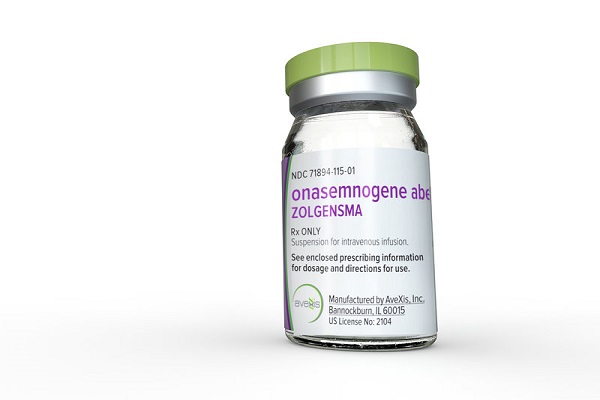At $2.1 Million, New Gene Therapy Is The Most Expensive Drug Ever
The federal Food and Drug Administration has approved a gene therapy for a rare childhood disorder that is now the most expensive drug on the market. It costs $2.125 million per patient.
The federal Food and Drug Administration has approved a gene therapy for a rare childhood disorder that is now the most expensive drug on the market. It costs $2.125 million per patient.
But for those patients lucky enough to get it, it appears it can save their lives with a one-time treatment.
Three-year-old Donovan Weisgarber is one of those patients. When he was born he seemed perfectly healthy. But within weeks, it became clear something was terribly wrong.
"It was about when he was about one month old that when we started to notice some symptoms," says his mother, Laura Weisgarber, 32, of Columbus, Ohio.
Donovan started getting really fussy, stopped squirming, and got weaker and weaker.
Donovan had spinal muscular atrophy (SMA), a rare disorder caused by a defective gene; the illness destroys the nerves that control muscles. Babies with the most severe form of the disorder typically don"t live past their second birthday.
"We were devastated," Weisgarber says, recalling the diagnosis. "It was definitely the worst time of our lives."
But then doctors told Laura and her husband, Matthew, about an experimental gene therapy that was being tested for SMA. So they agreed to let them infuse Donovan with genetically modified viruses carrying healthy copies of the gene he needed.
Donovan slowly started to improve. Donovan still needs a wheelchair to get around and a feeding tube for nutrition. But otherwise he"s doing well, his mother says.
"He loves going outside. He loves playing with his family. He goes to preschool," Weisgarber says. "He gets to do a lot of normal things. It"s amazing."
And Donovan isn"t alone. The gene therapy — called Zolgensma — has been saving other babies with spinal muscular atrophy.
"We saw just remarkable results for these kids," says David Lennon, president of AveXis,Inc., of Bannockburn, Ill., the company that developed Zolgensma. The company is owned by drug giant Novartis. (AveXis connected NPR with the Weisgarber family.)
Based on the AveXis studies, the FDA approved Zolgensma Friday, making it only the second gene therapy ever approved for a genetic disorder. There are currently around 700 patients eligible for the treatment, according to Novartis, and roughly 30 babies are born each month with the disease.
Novartis set the price at $2.125 million but offers insurers the ability to pay $425,000 a year for five years. This price tag makes Zolgensma the most expensive drug ever approved.
"It"s absolutely stunning," says Peter Bach, who studies health policy at Memorial Sloan Kettering Cancer Center in New York.
Zolgensma"s price tag, he says, is just the most extreme example of how drug prices are draining resources from society. The first gene therapy for an inherited disease was approved in 2017 for a genetic form of blindness. It is also very expensive — $425,000 for each eye.
"We have been slowly subjected to price increases the same way the frog in the boiling water is slowly boiled to death," Bach says.
Insurers are expected to cover the cost. The company says payment plans will be available.
AveXis president Lennon acknowledges the numbers might seem shocking. But he argues the drug is easily worth it. The only existing treatment for spinal muscular atrophy, a drug called Spinraza, costs hundreds of thousands of dollars a year. Zolgensma hopefully will be a one-time, life-saving treatment.
"We"re talking about a lifetime of benefit being condensed down into a one-time treatment," Lennon says. "We"re not used to thinking about this that way. We"re used to a system of a chronic medication where we spread things out over years if not decades."
The drug is delivered as a single one-time dose to address the genetic root cause of the disorder, the company says, producing long-term effects.
From that point of view, Lennon calls it "highly cost-effective" and a "fair and reasonable price."
Drug companies need to be able to recoup the costs of developing life-saving, cutting-edge treatments, he says, if they"re going to be encouraged to find new breakthroughs.
"We"re continuing to reinvest in new therapies beyond Zolgensma into the next wave of gene therapies that are going to hopefully offer cures for other diseases," Lennon says.
At one point, Novartis said publicly that the price of Zolgensma might be as high as $5 million.
"Insurers were going to cover Zolgensma no matter the price," says Dr. Steven D. Pearson, president of the nonprofit Institute for Clinical and Economic Review in Boston, an independent research group that studies drug pricing. "It is a positive outcome for patients and the entire health system that Novartis instead chose to price Zolgensma at a level that more fairly aligns with the benefits for these children and their families."
ICER estimated that a reasonable price would be between $1.2 and $2.1 million per treatment, based on an estimate of years of quality life valued at $100,000 to $15o,000 per year.
Donovan"s parents didn"t have to pay for the treatment because their son was part of a research study. But they think Zolgensma is worth the price.
"I understand that it can be shocking when you see a price tag on a treatment like this," Weisbarger says. "But giving someone a life — someone that would have died in infancy or early childhood the opportunity to live into adulthood — I think that"s a valuable investment."
The company says it has been manufacturing the drug since January and supplies of the drug will be released "shortly," Lennon says.





ارسال به دوستان